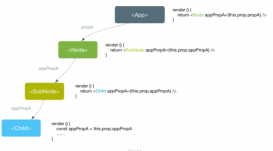打算記流水賬一般細數(shù)一下 React 中的 this 指向問題,具體流程按事件三要素:起因,經(jīng)過,結(jié)果。哈哈哈哈哈!
起因:
眾所周知,React 的設(shè)計是響應式的,使用者無需操縱 DOM,操縱數(shù)據(jù),頁面就會渲染更新。
數(shù)據(jù)一變就更新,是更新所有的 DOM 嗎?當然不是,哪些變了就重新渲染哪些。那就要對數(shù)據(jù)變化前后的 DOM 進行比較。直接對比真實 DOM 嗎?這樣性能會很低,React 比較的是虛擬 DOM,虛擬 DOM 也是對象,只不過相較真實 DOM而言,少了很多屬性,更“輕”。
如何寫虛擬 DOM 呢?原生JS我們可以使用 document.createElement() 方法,創(chuàng)建節(jié)點。React 中也可以通過 React.createElement(component, props, children),但是呢這種寫法遇見多層嵌套,就能讓人眼花繚亂。于是 JSX “橫空出世”,JSX 其實就是,React.createElement 的語法糖,但是我們用起來更加方便,可以直接寫成 <p id="test">hello</p> 這種形式。
但是呢問題又又來了!JSX 語法是不被 webpack 識別的,webpack 默認只能處理 .js 后綴名的文件,所以需要借助 Babel 這個 JavaScript 編譯器,而 babel 開啟了嚴格模式 **
|
1
2
3
4
5
6
7
8
9
10
11
12
13
14
15
|
import React, { Component } from 'react'export default class index extends Component { // speak(){ // console.log(this)//輸出undefined // } speak = () => console.log(this)//輸出該組件 render() { return ( <div> <button onClick={this.speak}>按鈕</button> </div> ) }} |
this 本質(zhì)上就是指向它的調(diào)用者,this 是在函數(shù)運行時才綁定,JS 里邊普通函數(shù)都是 window 調(diào)用的,所以指向 window,開啟了嚴格模式之后是 undefined。
|
1
2
3
|
(function(){ console.log(this)//window})() |
在 JSX 中傳遞的事件不是一個字符串(在原生 JS 的中監(jiān)聽事件,采用的是回調(diào)函數(shù)的形式,在Vue中給監(jiān)聽事件傳遞的是字符串變量),而是一個函數(shù)(如上面的:onClick={this.speak}),此時onClick即是中間變量,最終是由React調(diào)用該函數(shù),而因為開啟了嚴格模式的緣故,this 是undefined,所以處理函數(shù)中的this指向會丟失。
經(jīng)過:
事實上我們需要的是 this 指向當前實例化對象,無疑會使代碼編寫方便很多。類式組件里邊有兩地方的this恰好指向當前實例化對象。
1.構(gòu)造函數(shù)
類式組件里面的構(gòu)造器里面的this是指向?qū)嵗龑ο蟮模@是 ES6 類的特性,
眾所周知 Javascript 里面是沒有像 C++,JAVA 里面的的類的概念,ES6 類的實現(xiàn)也是基于原型鏈來實現(xiàn)的,
在 ES6 以前實例化一個對象應該這樣:
|
1
2
3
4
5
6
7
8
9
|
function Animal(name, age) { this.name = name this.age = age}Animal.prototype.say = function () { console.log(this.name)}const Dog = new Animal('dog', 3)Dog.say() //會在控制臺打印出dog |
其中的 new 運算符,先產(chǎn)生了一個空對象 {},然后生成一個 this 指針,將 this 指針指向這個空對象;運行構(gòu)造函數(shù)時,就相當于{}.name=dog,{}.age=3一樣的為這個對象動態(tài)添加屬性。最后將這個生成好的對象付給 Dog,
當我們使用 ES6 的 class 來聲明上面這個類的話,代碼如下:
|
1
2
3
4
5
6
7
8
9
10
11
|
class Animal { constructor(name, age) { this.name = name this.age = age } say() { console.log(this.name) }}const Dog = new Animal('dog', 3)Dog.say() //會在控制臺打印出dog |
類實現(xiàn)和上面應該大差不差,所以this是指向?qū)嵗龑ο蟮摹?/p>
2.render 函數(shù)
render 函數(shù)里面的 this,也是指向?qū)嵗摹樯赌兀?/p>
首先 render 方法是在類式組件的原型上邊的,React發(fā)現(xiàn)組件是使用類定義的時候,后邊就會 new 出來該類的實例,注意這個實例是 React 幫你 new 出來的,隨后實例調(diào)用 render 方法,將虛擬 DOM 轉(zhuǎn)換為真實 DOM,所以 render 中的this 就是指向?qū)嵗吘故撬{(diào)用的嘛!,類似的呢,render 是一個生命周期鉤子,那其他的生命周期鉤子里面的 this也是指向?qū)嵗M件的。
3.bind 和箭頭函數(shù)
解決 this 問題呢,要有兩個知識儲
(1)bind
call apply bind 都是定義在函數(shù)原型上邊的,用來改變函數(shù) this 指向,傳入的第一個參數(shù)是 this,后面的參數(shù)就是fun1的參數(shù)
區(qū)別:
- call 和 bind 傳給調(diào)用的函數(shù)是可以傳多個 apply 則是將參數(shù)放進一個數(shù)組
- call 和 apply 返回立即執(zhí)行函數(shù),bind 返回新的函數(shù),bind()() 也是立即執(zhí)行
- 使用 bind 綁定 this 后,該函數(shù)里面的 this 不能變化了,不論是誰調(diào)用
|
1
2
3
4
5
6
7
8
9
10
11
12
13
14
15
16
|
let aa = { fun1: function(a,b){ console.log(this) console.log(a-b); }} let bb = { fun2: function(a,b){ console.log(this) console.log(a+b); }}aa.fun1.call(bb,11,22);//bb-11bb.fun2.apply(aa,[11,22]);//aa 33aa.fun1.bind(bb,11,22)();//bb -11 |
(2)箭頭函數(shù)
箭頭函數(shù):箭頭函數(shù)并不會創(chuàng)建自己的執(zhí)行上下文,所以箭頭函數(shù)中的this都是外層的this,會向外作用域中,一層層查找this,直到有 this 的定義
|
1
2
3
4
5
6
7
8
9
10
11
12
13
14
|
const A = { arrow:() =>{ console.log(this)//window }, func:function(){ this.arrow()//window console.log(this)//A setTimeout(() => { console.log(this)//A }); }}A.arrow()A.func() |
結(jié)果:
解決方法俺會兩,嘿嘿!
方法一:在構(gòu)造函數(shù)中使用bind
|
1
2
3
4
5
6
7
8
9
10
11
12
13
14
15
16
17
18
19
20
21
|
import React, { Component } from 'react'export default class index extends Component { constructor(){ super() this.speak = this.speak.bind(this) /*解決類中的this問題:this.speak = this.speak.bind(this),構(gòu)造器里面的this默認指向?qū)嵗龑ο螅?/code> 實例對象通過原型鏈在類的原型上找著fnc函數(shù),通過bind函數(shù)將其this指向改為實例對象,并返回一個新的函數(shù) 再將這個新的函數(shù)給實例,并取名為fnc*/ } speak(){ console.log(this)//輸出當前實例對象 } render() { return ( <div> <button onClick={this.speak}>按鈕</button> </div> ) }} |
方法二:將箭頭函數(shù)賦值給類的屬性
|
1
2
3
4
5
6
7
8
9
10
11
12
13
14
|
import React, { Component } from 'react'export default class index extends Component { speak = () =>{ console.log(this) } render() { return ( <div> <button onClick={this.speak}>按鈕</button> </div> ) }}//需要傳參的話,可以使用函數(shù)柯里化的思想 |
注意:性能存在差異
使用箭頭函數(shù)來解決性能會比較低,因為箭頭函數(shù)不是方法,它們是匿名函數(shù)表達式,所以將它們添加到類中的唯一方法是賦值給屬性。前面介紹ES6的類的時候可以看出來,ES 類以完全不同的方式處理方法和屬性
方法被添加到類的原型中,而不是每個實例定義一次。
類屬性語法是為相同的屬性分配給每一個實例的語法糖,實際上會在 constructor里面這樣實現(xiàn):
|
1
2
3
4
|
constructor(){ super() this.speak = () => {console.log(this)}} |
這意味著新實例被創(chuàng)建時,函數(shù)就會被重新定義,丟失了JS實例共享原型方法的優(yōu)勢。而方法一,只是在生成實例時多了一步 bind 操作,在效率與內(nèi)存占用上都有極大的優(yōu)勢
以上就是詳解React中的this指向的詳細內(nèi)容,更多關(guān)于React中的this指向的資料請關(guān)注服務(wù)器之家其它相關(guān)文章!
原文鏈接:https://juejin.cn/post/6954636599892279304
















